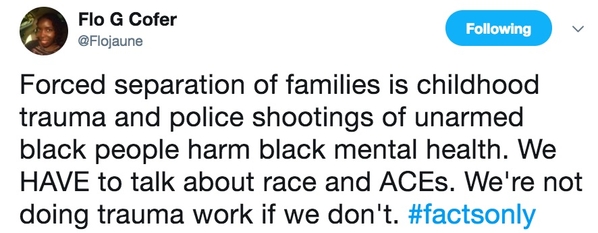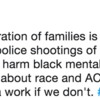In response to the Trump administration policy of family separations at the border and this article released about the impact of police killings on African American mental health, Resilient Sacramento member Dr. Flojaune G. Cofer tweeted the following:
As this perspective gains momentum in the trauma-informed field, there are ACEs communities committed to doing trauma work that centers race, and other forms of structural oppression, as sources of trauma. Resilient Sacramento has recently made this commitment explicit, sharing several resources on their page that we thought would be valuable to the entire ACEs Connection community.
This blog post lists just the handful of resources shared at a recent Resilient Sacramento meeting. All of these attached documents can also be found in the ACEs Connection Resource Center, under the category ACEs Science and Racism. Additional resources will continue to be added to this category.
After the fatal police shooting of Stephon Clark in Sacramento on March 18, 2018, the Sacramento community erupted in pain and rage. City council meetings were filled to overflowing; the local Black Lives Matter chapter mobilized hundreds of protesters, including two actions that blocked traffic on the I-5 Freeway and another that prevented ticket holders from entering the Sacramento Kings Arena for an active game, making national headlines. The latter action resulted in the Kings supporting the establishment of a Build Black initiative, with the aim to find ways to support a black community in distress. City Council members agreed to help concentrate mental health resources in Meadowview, a low income, predominantly African American community in South Sacramento, where Stephon Clark was killed. National advocates for the black community flocked to the city to offer support.
In the midst of all of this distress, the members of Resilient Sacramento recognized two things: that as a collaborative focused on building a trauma informed and resilient community, the group was both uniquely suited, and significantly unprepared, to respond to this crisis.
From that moment, the members of Resilient Sacramento committed to integrating racism and other structural oppressions into the way members educate and advocate for community resilience.
One of the first steps was to focus a monthly community meeting on best practices in understanding racism as trauma, in order to increase members' knowledge in this area. The following resources described below and attached to this post, were shared and workshopped at this meeting. Note: the linked post includes these same resources. A more extended description is provided in this current post.
1) The RYSE Pyramid: RYSE Youth Center, Richmond, CA
"If it's not racially aware, it's not trauma-informed". This attachment is a photo of a poster RYSE created to explain their theoretical reconceptualization of the ecological ACEs pyramid. The reimagined pyramid adds two levels, intergenerational transmission of trauma and structural conditions, as well as deepens the understanding of the disease generating processes at each of the other levels. RYSE co-director Kanwarpal Dhaliwal described this work in this post on acesconnection.com.
2) RYSE Interacting Layers of Trauma and Healing: RYSE Youth Center, Richmond, CA
This conceptual framework deepens RYSE's earlier work, highlighting the need to understand trauma impacts on four interacting levels: 1) individual and interpersonal, 2) community and place, 3) systems and institutions, 4) history, legacy and structures. This framework also begins to identify the sources of trauma from oppression, and given these sources, what practices are likely to promote healing.
3) Multidimensional View of Self: Dr. Kenneth Hardy
Dr. Kenneth Hardy writes and lectures on the topic of sociocultural trauma. In his public lectures, he has explained that his work on sociocultural trauma, he identified the need to first build skills for having productive conversations about race. Audiences had a hard time engaging the complexities and nuances of sociocultural trauma because they lacked a primary foundation in understanding race and ethnicity. The attached poster, titled How to Talk Effectively About Race, provides a single page view of Dr. Kenneth Hardy's theory of the multi-dimensional view of self, which has become a helpful teaching tool and skill-builder for engaging in conversations about race in general, and further in the context of the traumatogenic character of racism.
4) Healing Organizations chart: Trauma Transformed (T2), Oakland, CA
Given the structural nature of traumatic oppressions, it becomes essential to have an intentional strategy for shifting structures at the organizational level. The work of Trauma Transformed is focused on training and supporting organizations to become trauma informed. Nicknamed "T-squared", T2 has developed an organizational flow chart of the journey from awareness to truly becoming a healing organization. T2 explicitly includes a racial analysis in its work of transforming organizational cultures to become trauma-informed.
5) Race Equity Crosswalk Tool: Annie E. Casey Foundation
This document helps organizations move from an intellectual commitment to equity, to a concrete, measurable action plan.
6) Racial Equity Core Competencies: Center for the Study of Social Policy
Framed as competencies, this tool is a great model of a serious organizational commitment to improving its own outcomes regarding racial equity, through intentional development of knowledge, skills, and attitudes that push internal racial equity forward.
7) Building a Race Equity Culture: Equity In the Center
This framework helps organizations think through and plan around shifting their organizational culture toward racial equity. Specifically, this approach raises staff and leadership awareness of the four levels of racism and how to take concrete steps to redress equity gaps at each level.
8) Racial and Economic Justice Framework: Baltimore City Breakthrough Series Collaborative, Baltimore, MD
The BSC model was used in Baltimore to work toward building a resilient community in that city, in which resilience could be measured and shared as a best practice. This effort also explicitly incorporated race and economic justice as a core component of building community resilience. The final report of that effort was shared in the Resilient Sacramento best practices meeting.
Please include this citation when circulating the attached BSC report:
Agosti, J., MPP, Connors, K., MSW, LCSW-C, Hisle, B., MSW, Kiser, L., PhD, Streider, F., PhD, Thompson, E., PhD. Baltimore: A Trauma and Resilience Informed City for Children and Families – Breakthrough Series Collaborative Final Report. The Baltimore Partnership for Family and Trauma-Informed Care (2016).





Comments (2)